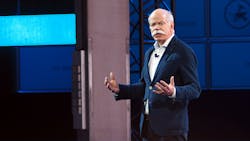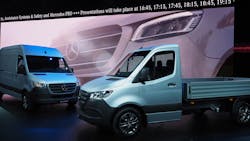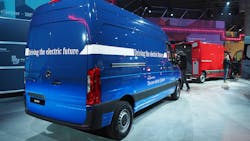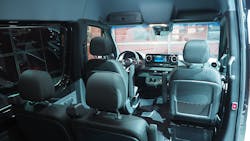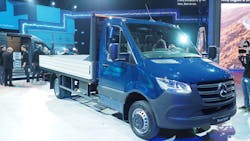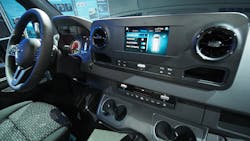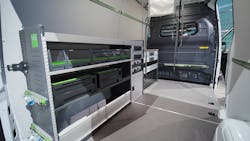Age of the smartvan: 'Benz shows off 'next level' Sprinter's business, digital talent
(Photos by Aaron Marsh/ Fleet Owner)
DUISBURG, GERMANY. From passenger transport to mobile tradesmen to e-commerce and grocery delivery, Mercedes-Benz touted its new Sprinter at its launch as the "Kleenex" of the HD van transportation industry — a brand name synonymous with the product type. The third-generation Sprinter is designed to service a broad range of commercial needs as well as those of consumers in a connected, digital world.
That's the vision, at least. The automaker said it sold a record more than 200,000 of the current-model Sprinter globally last year — notably even with the new vehicle on the way — and some 26,000 of those sales were in the U.S. market. At the new Sprinter's unveiling in Duisburg, Germany on Tuesday, Mercedes-Benz highlighted the extended configurability and digital horsepower of its flagship commercial product.
"The Sprinter is for Mercedes-Benz Vans what the S-Class is for our passenger cars. It's an icon — it's the core of the brand, the driving force behind change and technological innovation," said Dr. Dieter Zetsche (below), head of Mercedes-Benz Cars and chairman of the Daimler AG Board of Management, via translator. The best possible work vehicle for businesses today comes down to both hardware and software, he added.
"This is what 'next level' means to us," he said, explaining the company's CASE design philosophy (Connected, Autonomous, Shared & Services and Electric). Digital connectivity and access to vehicle data are part and parcel to the new van, and the OEM is betting that businesses can't afford to ignore those things.
"It might be useful for a driver to use a smartphone app to access key vehicle data. But for a fleet customer, this might be a solid competitive advantage. So why should they ignore that?" Zetsche said.
The company showed off a variety of the new Sprinter's possible configuratations and available features at the event.
Supplementing the available Mercedes PRO connect fleet management services that can be baked in from the factory, the "Sprinter 3.0" is only the second Mercedes-Benz vehicle to receive the optional new MBUX infotainment/user experience system the company announced last month. It could just as well be called a user interface.
"MBUX will fundamentally change the way we interact with our vehicles or navigate to new destinations," Zetsche contended. "MBUX is capable of learning, and it adapts to the individual needs of drivers.
Screen image displayed at the unveiling.
"Many functions, like navigation to exactly the right loading dock to a position of 1m, are going to help commercial users in particular," he added. (Watch for a hands-on Fleet Owner demo of MBUX still to come.)
'Smart hardware'
Since its European introduction in 1995 — though a U.S. intro came in 2001 under the Freightliner brand — the Sprinter has earned a reputation for reliability, flexibility and economical operation, argued Volker Mornhinweg (below), head of Mercedes-Benz Vans. More than 3.4 million Sprinters have been sold worldwide over the last 23 years.
But M-B Vans recognizes that a new business environment has evolved in that time as well, he said, and designed the new Sprinter accordingly. In today's advanced-tech business climate, you might think of it as the emergence of the smartvan.
"The new Sprinter has been turned into smart hardware, in a way," Mornhinweg said through the translator. After all, he'd noted earlier, "our customers have to deal with a new, changed playing field. The urban space gets denser, supply chains get more complex, delivery times get shorter and sustainability gets even more important."
An electric version -- the eSprinter -- is due to launch first in Europe next year, offering additional options for services like urban package or pickup/delivery operations.
The Sprinter will be built stronger than before, he noted, but it also will get a complement of intelligent products and services. Mornhinweg reiterated his analogy from the Sprinter Innovation Campus in December that the new Sprinter compared to traditional work vans is like the smartphone vs. a basic cellular phone. He referred to the upcoming Mercedes PRO connect telematics services that Sprinter customers will be able to include as "the operating system, so to speak, of our Sprinter hardware."
Taken together, the company pitched the Sprinter as the modern business' transportation tool. "The new Sprinter becomes an integral part of the value-creation chain for our customers," Mornhinweg said. "We open up a new level in terms of flexibility, connectivity and profitability, and this is made to suit your individual industry."
New Sprinter at the event outfitted for passenger transport and equipped with MBUX infotainment system.
The current Sprinter model already included a range of advanced safety features such as brake assist, lane-keeping assist, blind spot monitoring, crosswind stability assist and a drowsy-driving alert. The new Sprinter will build on those, for instance, with a parking assist package that includes a 360-degree camera view with a radar-based distance control system.
'Multitalented all-rounder'
The vehicle's optional body lengths, body types, roof height, engine options, weight ratings and drive systems add up to 1,700 possible variants; that's the global view. Some of the biggest changes vs. the outgoing model won't make it to the U.S. market — at least not initially — including a front-wheel-drive option that won't be offered in the United States and an electric-powered eSprinter slated to arrive first in Europe in 2019.
New Sprinter cab chassis ready for load-hauling.
Even so, the Sprinter's attributes will help businesses tap into new possibilities such as more adept express courier/package delivery services and perhaps even to remain profitable in an increasingly challenging market, according to Mornhinweg. Some 3 billion packages were delivered in 2016 in Germany alone, he said, and that could climb to 4 billion by 2020, and e-commerce is driving similar increases in other countries.
"The cost pressure of it is enormous, because the average revenue per parcel is going down," he contended. It was clear at the launch M-B Vans aimed to design the new Sprinter to be something of a jack of all trades — or maybe more accurately, a master of many of them.
Interior options on a new Sprinter -- note cupholders.
"Imagine companies delivering cement bags to a construction site, groceries to the farmer's market and VIPs to the opera house," Mornhinweg suggested. On that last point, configured for passenger transport, the Sprinter offers more comfort; look for things like more cupholders and places to shelve and charge smartphones available and front/rear seats designed to be more comfortable. An available multi-user WiFi hotspot can help please passengers especially on long trips, he noted.
With growing upfit possibilities thanks to Mercedes-Benz's MasterSolutions program launched in 2016, the Sprinter is often found in specialty and "top-shalf" service roles such as mobile vehicle repair and executive shuttle. At the same time, a major chunk of Sprinter sales are for vans upfit as campers/RVs — including in the North American market — and the company wants to capitalize on that popularity as well.
Upfit cargo area of a new Sprinter displayed at the van's premiere.
"The Sprinter is more versatile than ever before, because it must be an 'all-rounder' — a multitalented all-rounder," Mornhinweg said.
Browse through our extended slideshow for Fleet Owner's walk around (and inside) of more than half a dozen new Sprinters that Mercedes-Benz showed off at the event and check back for additional information the company provided.
About the Author
Aaron Marsh
Aaron Marsh is a former senior editor of FleetOwner, who wrote for the publication from 2015 to 2019.
